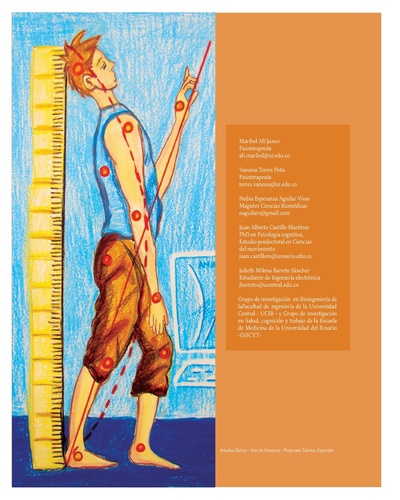Aplicaciones tecnológicas en análisis de movimiento: diagnóstico y seguimiento para procesos fisioterapéuticos
Contenido principal del artículo
Autores
Maribel Alí Juncoali.maribel@ur.edu.co
Vanessa Torres Peña
torres.vanessa@ur.edu.co
Nubia Esperanza Aguilar Vivas
naguilarv@gmail.com
Juan Alberto Castillo Martínez
juan.castillom@urosario.edu.co
Julieth Milena Barreto Sánchez
jbarreto1@ucentral.edu.co
Resumen
El presente trabajo muestra las perspectivas de aplicación y uso de la tecnología de análisis de movimiento para el diagnóstico y seguimiento en procesos terapéuticos, mediante el análisis de parámetros de movimiento, apoyado en la tecnología de BTS SMART-E. Esta tecnología permite el análisis de la cinemática de los movimientos corporales y registra datos e imágenes en tres dimensiones (3D), para permitir en análisis y la valoración del movimiento en los planos frontal, sagital y trasversal. El objetivo de este estudio es mostrar las posibles aplicaciones y el uso de esta tecnología. Se presentan los modelos para tres estudios de aplicación realizados: balance corporal, comportamiento de mano luego de una enfermedad cerebro vascular (ECV) y análisis de inestabilidad en columna lumbar. Estos modelos muestran la posibilidad de medir el comportamiento de uno o varios ángulos, en cuanto al desplazamiento, la velocidad y la aceleración. Este tipo de tecnología permite objetivar la evaluación y garantiza la reproducción de las pruebas en diferentes escenarios.
Palabras clave:
Detalles del artículo
Licencia
Aquellos autores/as que tengan publicaciones con esta revista, aceptan los términos siguientes:
- Los autores/as conservarán sus derechos de autor y garantizarán a la revista el derecho de primera publicación de su obra, el cuál estará simultáneamente sujeto a la Licencia de reconocimiento de Creative Commons que permite a terceros compartir la obra siempre que se indique su autor y su primera publicación esta revista.
- Los autores/as podrán adoptar otros acuerdos de licencia no exclusiva de distribución de la versión de la obra publicada (p. ej.: depositarla en un archivo telemático institucional o publicarla en un volumen monográfico) siempre que se indique la publicación inicial en esta revista.
- Se permite y recomienda a los autores/as difundir su obra a través de Internet (p. ej.: en archivos telemáticos institucionales o en su página web) antes y durante el proceso de envío, lo cual puede producir intercambios interesantes y aumentar las citas de la obra publicada. (Véase El efecto del acceso abierto).
Los autores que publican en la revista se acogen al código de licencia de Creative Commons Atribución 4.0 Internacional (CC BY 4.0)




Referencias
Pérez R, Costa U, Torrent M, Solana J, Opisso E, Cáceres C, et al. Upper Limb Portable Motion Analysis System Based on Inertial Technology for Neurorehabilitation Purposes. Sensors 2010; 10: 1073310751.
Cerveri P, De momi E, Marchente M, Lopomo N, Baud-bovy G, Barros R. M. L, Ferrigno G. In Vivo Validation of a Realistic Kinematic Model for the Trapezio-Metacarpal Joint Using an Optoelectronic System. Annals of Biomedical Engineering 2008; 36: 1268–1280.
Stagni R, Fantozzi S, Cappello A, Leardini A. Quantification of soft tissue artefact in motion analysis by combining 3D fluoroscopy and stereophotogrammetry: a study on two subjects. Clinical Biomechanics 2005; 20: 320–329.
Sutherland D.H. The evolution of clinical gait analysis part III – kinetics and energy assessment. Gait & Posture 2005; 21: 447–461.
Anderst W, Baillargeon E, Donaldson W, Lee J, Kang J, Validation of a Noninvasive Technique to Precisely Measure In Vivo Three-Dimensional Cervical Spine Movement. Spinejournal 2011; 36: 393–400.
Mündermann L, Corazza S, Andriacchi T. The evolution of methods for the capture of human movement leading to markerless motion capture for biomechanical applications. Journal of NeuroEngineering and Rehabilitation 2006, 3:6.
Simon S. Quantification of human motion: gait analysis—benefits and limitations to its application to clinical problems. Journal of Biomechanics 2004; 37: 1869–1880.
Adams D, Cerney M. Quantifying biomechanical motion using Procrustes motion analysis. Journal of Biomechanics 2007; 40: 437–444.
Chang F, Rhodes J, Flynn K, Carollo J. The Role of Gait Analysis in Treating Gait Abnormalities in Cerebral Palsy. Orthop Clin N Am 2010; 41: 489–506.
Cowan s, Bennell k, Crossley k, Hodges p, Mcconnell j. Physical therapy alters recruitment of the vasti in patellofemoral pain syndrome. Medicine & Science In Sports & Exercise. 2002; 3412-1879.
Rusaw D. Ramstrand N. Motion-analysis studies of transtibial prosthesis users: a systematic review. Prosthetics and Orthotics International 2011; 35: 8–19.
Gianikellis, K. Características técnicas y prestaciones de los sistemas optoelectrónicos más difundidos en el campo de la biomecánica del movimiento humano. Estado actual de conocimientos. Revista Motricidad 1996; 2, 191-210.
Cramp E, Manual of Motion Lab Systems Inc. 2009. August 19.
Jobbágy Á, Furnée E.H, Gyöngy L, Monos E, Harcos P, Martin F. Biomedical Applications Of A Precision Motion Analysis System. Technical University of Budapest, Dept. Measurement and Instrument Engineering. 1994. URL: http://home.mit.bme.hu/~jobbagy/publ/ mechatr97.htm. Cconsultado: junio 10/2011.
lan-yuen guo, fong-chin su, chich-haung yang, shu-hui wang, jyh-jong chang, wen-lan wu, et al. Effects Of Speed And Incline On Lower Extremity Kinematics During Treadmill Jogging In Healthy Subjects. Biomedical engineering-applications 2006; 18.
Sheng-che lin, tsan-hsun huang, fong-chin su, you -li chou. Motion Analysis Of Mouth Movement Utilizing Challis Technique-Experiment Model And Clinical Study Using Video-Based System. Biomedical engineering-applications 2002; 14.
Figueroa P, Leite N, Barros R. A flexible software for tracking of markers used in human motion analysis. Biomedicine 2003; 72: 155-165.
Cereatti A, Croce U, Cappozzo A. Reconstruction of skeletal movement using skin markers: comparative assessment of bone pose estimators. Journal of NeuroEngineering and Rehabilitation 2006, 3:7.
Rueterboriesa J, Spaicha E, Larsenb B, Andersena O. Methods for gait event detection and analysis in ambulatory systems. Medical Engineering & Physics 2010; 32: 545–552.
Uluçam E, Sabri B. Measurement of Normal Lumbar Spine Range of Motion in the College-Aged Turkish Population Using a 3D Ultrasound-Based Motion Analysis System. Trakya Üniversitesi Tıp Fakültesi Dergisi. 2009; Cilt 26, Sayı 1, Sayfa (lar) 029-035.
Tik-Pui D, Hong Y, Li J. Lower extremity preventive measures for slips – joint moments and myoelectric analysis. Ergonomics 2008; Vol. 51, No. 12; 1830–1846.
Bazański T. Original paper Metacarpophalangeal joint kinematics during a grip of everyday objects using the three-dimensional motion analysis system. Acta of Bioengineering and Biomechanics 2010; Vol. 12, No. 2.
Wolf A, Senesh M. Estimating joint kinematics from skin motion observation: modelling and validation. Computer Methods in Biomechanics and Biomedical Engineering First article, 2011, 1–8.
Barton C, Levinger P, Crossley K, Webster K, Menz H. Relationships between the Foot Posture Index and foot kinematics during gait in individuals with and without patellofemoral pain syndrome. Journal of Foot and Ankle Research 2011; 4:10.
Levinger P, Gilleard W. Relationship Between Static Posture and Rearfoot Motion During Walking in Patellofemoral Pain Syndrome Effect of a Reference Posture for Gait Analysis. J Am Podiatr Med Assoc 2006; 4: 323-329.
Chuter V. Relationships between foot type and dynamic rearfoot frontal plane motion. Chuter Journal of Foot and Ankle Research 2010, 3:9.
Stebbins J, Harrington M, Thompson N, Zavatsky A, Theologis T. Repeatability of a model for measuring multi-segment foot kinematics in children. Gait & Posture 2006; 23:401–410. 2005.
Wright C, Arnold B, Coffey T, Pidco P. Repeatability of the modified Oxford foot model during gait in healthy adults. Gait & Posture 2011; 33: 108–112.
Chiu H, Su F, Wang S, Hsu H. The motion analysis system and goniometry of the finger joints. Journal of Hand Surgery 1998; 23B: 788-791.
Ting H, Kuo L, Yi L, Wu W, Su F. The three-dimensional analysis of three thumb joints coordination in activities of daily living. Clinical Biomechanics 2011; 26: 371–376.
Shorter A, Polk, Rosengren K, Hsiao-Wecksler E. A new approach to detecting asymmetries in gait. Clinical Biomechanics 2008; 23:459– 467.
Cappozzo A, Croce U, Leardini A Chiari L. Human movement analysis using stereophotogrammetry Part 1: theoretical background. Gait and Posture 2005; 21: 186-196.
Chiari L, Croce U, Leardini A, Cappozzo A. Human movement analysis using stereophotogrammetry Part 2: Instrumental errors. Gait and Posture 2005; 21: 197–21.
Gil A, Pérez S, Forner A, Pérez E, Crespo B, Del Ama A. Gait kinematic analysis in patients with a mild form of central cord syndrome. Journal of Neuro Engineering and Rehabilitation 2011; 8:7.
Carson M, Harrington M, Thompson N, O’Connor J, Theologisc T. Kinematic analysis of a multi-segment foot model for research and clinical applications: a repeatability analysis. Journal of Biomechanics 2001; 34:1299–1307.
Groote F, Laet T, Jonkers I, Schutter J. Kalman smoothing improves the estimation of joint kinematics and kinetics in marker-based human gait analysis. Journal of Biomechanics 2008; 41: 3390–3398
Davis III R, Ounpuu S, Tyburski D, Gage J. A gait analysis data collection and reduction technique. Human movement science 1991; 10:575587.
Tinetti ME, Williams TF, Mayewski R, Fall Risk Index for elderly patients based on number of chronic disabilities. Am J Med 1986:80:429434.
Dutton M. Manual therapy of the spine an integrated approach. España. McGraw-Hill 2002.
Álvarez M, Benítez M, Espinosa J, Gorroñogoitia A, Muñoz F, Regato P. Atención A Las Personas Mayores desde la Atención Primaria. Barcelona. Semfyc.


 PDF
PDF










